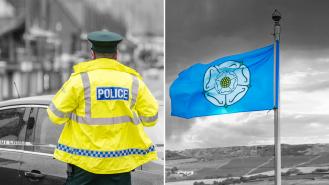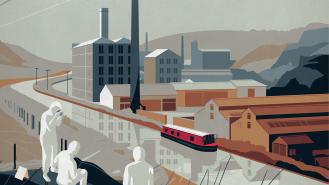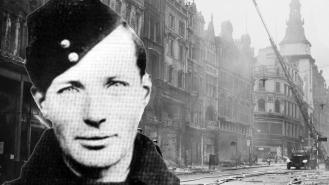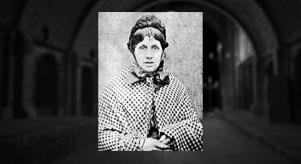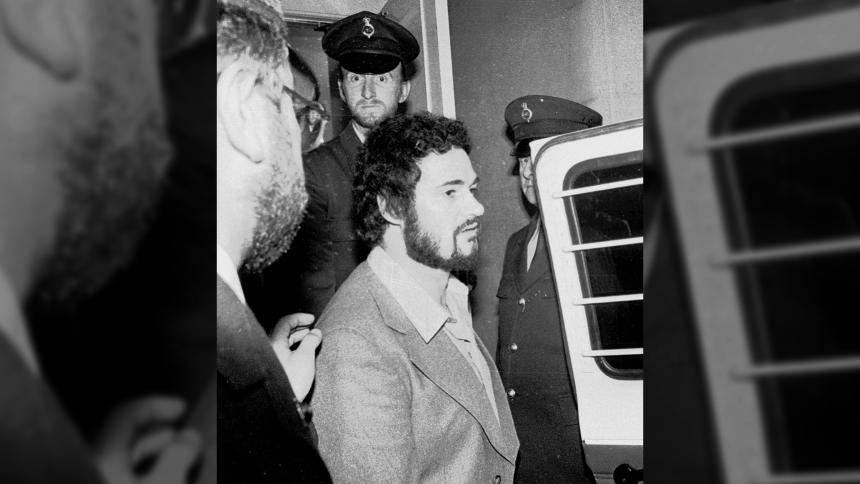
How the Yorkshire Ripper terrorised a community
Richard Bevan was 12 years of age and living in Huddersfield when The Yorkshire Ripper butchered his first victim and was 18 when Peter Sutcliffe, the man who had terrorised the north for half a decade was convicted of 13 murders and 7 other attempts to kill vulnerable women. The writer looks back at living a childhood and youth under the shadow of one of the UK's worst serial killers.
Nearly forty years have passed since Peter Sutcliffe dubbed by the press as the ‘Yorkshire Ripper’ stood trial for the murder of 13 women and attempted murder of seven more at Dewsbury Crown Court on January 5th 1981. His arrest by sheer fluke just three days before when he was questioned by two police officers out on patrol in Sheffield brought to an end the longest period of serial killing in the UK and the biggest manhunt in British police history. As a youth of seventeen at the time living in Huddersfield, I remember well the sense of relief that a madman had been taken off the streets.
Sergeant Bob Ring and Constable Robert Hydes while patrolling the red light area of Sheffield in South Yorkshire had spotted a known prostitute getting into Sutcliffe’s car and decided to investigate. Ten minutes later they approached Sutcliffe’s vehicle in a secluded spot in the city’s Melbourne Place and questioned the man they had no idea at the time was the notorious serial killer who had been terrorising the north of England for half a decade. After conducting a PNC check on the car’s registration number it was discovered Sutcliffe was driving with false number plates. He was arrested on what was a minor offence and taken to Dewsbury police station for further questioning and locked up for the night. This chance, routine encounter led to Sergeant Bob Ring eventually going back to the scene of Sutcliffe’s arrest a day after the incident where he unearthed the killer’s deadly tools of his murderous trade. Shortly afterwards while still in custody at Dewsbury station Sutcliffe admitted to being the Yorkshire Ripper.
Waking up to the reality of a serial killer
While brutally murdering and attacking women from all walks of life - not just prostitutes as Sutcliffe later claimed was his ‘mission’ from God - the killer’s five-year reign of terror using hammers, screwdrivers and knives caused fear and terror amongst communities across Yorkshire and Manchester. Millions of citizens, particularly women and girls never knew when and where the sadistic killer would strike which towards the late 70s prompted volunteers and vigilantes to roam the streets in various parts of Yorkshire ‘to protect our women’. It could even be argued that awareness of a maniac at large over such a considerable time frame led many to develop coping strategies in order to be able to lead normal social lives. At the height of ‘Ripper’ awareness, most single women living in West Yorkshire adopted a cautionary attitude to going about their everyday business. Reminders to females not to walk the streets alone at night became second nature as well as there being collective bafflement as to how prostitutes could still walk the streets knowing that getting into a car with a stranger could be their last transaction. From the moment Sutcliffe became known as the Ripper with reference to Whitechapel’s infamous slayer of prostitutes, there wasn’t much sympathy for street workers, who at worst were regarded by society as subhuman or perceived somewhat patronisingly as hopeless, tragic creatures.
Trying to Live life as normal as possible
It is difficult to describe accurately the atmosphere at the time of the Yorkshire Ripper’s murderous activities, his identity unknown and being an enigma of the darkest kind meant he represented extreme bogeyman status. As boys and men, one feared for the women in your lives. Remarkably, despite the threat of attacks happening at any time life carried on unfettered without any obvious sense of curtailing freedoms.
Christmases came and went, children played in the streets, girls still went to discos, lovers continued to arrange dates in intimate places and I like many teenagers during the murders only paid scant attention to reports about the Ripper’s latest attacks in the occasional paper or catching news bulletins. An acute sense of awareness and paranoia would usually only occur after a vicious murder had taken place which sent the media into a frenzy causing even the most apathetic of locals to go into a temporary state of high alert.
Ripper myths
And yet despite the horrors inflicted by Sutcliffe on unsuspecting victims in such a random manner there still persisted a myth and foolish misconception that women generally were safe from the Ripper apart from prostitutes. Whether this prejudicial belief grew out of desperate need to rationalise the brutality of such crimes is not clear, but it may have contributed to a more risk-taking attitude allowing Sutcliffe an opportunity to attack women unconnected with prostitution or red lights districts of towns and cities. As Ripper survivor Theresa Toth said in a BBC interview who was brutally assaulted by Sutcliffe near her home ‘I was sixteen year's old and you don’t think anybody’s going to go out and hurt you and at the time he was just going out after prostitutes'.
It was a subject that I myself as a youth strove to get across to a teenage female friend one night when both travelling on a bus from Halifax to Huddersfield. ‘Oh he only does hookers’ was the reply which sadly reflected in some areas of society a dispassionate view of Sutcliffe’s many early victims and where the worst of opinions was encapsulated in a reprehensible piece of graffiti scrawled on a side wall of a shopping arcade in Huddersfield. ‘Give the Ripper a medal’ callously displayed more hatred for vulnerable women earning a living selling sex than it did for an insane coward who was slicing them up. The graffiti remained, screaming out its inhumanity for weeks before the town’s council removed it. I wondered at the time, how many people passing this obscenity agreed with it even if just a little? The fact that earlier attacks on non-prostitutes Anna Rogulskyj and Olive Smelt not linked with the other Yorkshire Ripper murders may have resulted in complacency in the general population, who seemed to view prostitutes as somehow deserving of the Yorkshire Ripper's punishments.
Ordinary women attacked
Shortly after the first publicised ‘non-prostitute’ attacks occurred, beginning with the brutal slaying of 16-year-old Jayne MacDonald (possibly mistaken as a prostitute) in Leeds on the 26th June 1977, public opinion quickly changed. Jayne had only just taken on a new job in a shoe shop and was out celebrating with friends before deciding to walk home. After learning of her murder, her father lost the will to live and died two years later. It became evident that Sutcliffe’s murderous modus operandi did not discriminate. The world was soon informed through national papers and television news that ‘all women’ were potential victims of this unpredictable madman now labelled Yorkshire’s serial killer and the UK’s worst since Jack the Ripper.
As a schoolboy in Huddersfield at the time of Sutcliffe’s first attacks in 1975, it is strange looking back at those years to realise how disconnected many young people like myself were to something more horrifically real than a TV thriller or ‘slasher’ movie at the cinema. Popular horror flicks such as the ‘Halloween’ franchise and ‘Friday 13th’ had been thrilling and scaring the wits out of millions of cinemagoers during the late 70s and early 80s. The irony being that there was something far more real and repulsive roaming the streets at night than any amount of fake gore and pretend murders. But the spectre of a real serial killer targeting women across Yorkshire and areas of Manchester still gave way to a self-deluding attitude that ‘it couldn’t happen to me’ or a misconception that the murders only took place in dodgy areas of disrepute. Sutcliffe’s obscene slaying of sixteen-year-old MacDonald and later bank clerk Josephine Whitacker in Halifax altered perceptions quickly. No women were safe until the maniac was caught.
Conspiracy theories and paranoia
As there was often a lengthy interim of months, sometimes even a year between the murders, it could be expected that the public’s interest and sense of high alert waned at times. But for the most part during the five years of terror that Sutcliffe carried out his vile cowardly attacks, there was rarely a week or a day in West Yorkshire when the conversation didn’t turn to people’s thoughts and opinions about the killings and who the Ripper might be. This was a period well before the internet and social media and conspiracy theories ranging from the fanciful to ridiculous were either passed around like Chinese Whispers or encouraged by sensationalistic journalism. Everyone had a ‘theory’ from taxi drivers to shop assistants and as the media contributed to a culture of hearsay due to a lack of real evidence it is little wonder that a sense of paranoia fuelled individual’s ideas about the serial killer’s identity.
I recall conversations in pubs and cafes where strangers theorised about the Ripper’s occupation to whether he was English or ‘foreign’ to even musings on whether he was a member of the Masons or a Satanic cabal straight out of one of Dennis Wheatley’s occult novels. One eager crime author with an eye on the till even wrote a book naming the wrong man before Sutcliffe was arrested and convicted.
Ironically and perhaps to West Yorkshire Metropolitan Police’s great regret, the one person who guessed correctly about the Ripper’s identity and who contacted the police wasn’t even interviewed at the time. Trevor Birdsall, a friend of Sutcliffe and who occasionally accompanied him on excursions around red light districts in the 70’s, eventually informed the police about his suspicions only for his letter which had been marked ‘Priority 1’ to get lost amongst the mountains of paperwork in a pre-digital age which relied on an index cards system to file a quarter of a million names for cross-referencing. Neither was Birdsall’s visit to Bradford police station to express his misgivings about Sutcliffe ever followed up by the police. The actual report made out detailing his visit was also misplaced.
Murder on the doorstep
On January 31st, 1978 the gruesome bloody handiwork of the Yorkshire Ripper was brought closer to me and fellow school children when Sutcliffe’s eighth victim was found in Huddersfield. 18-year-old prostitute Helen Rytka had lived only streets away from both our school, Central Kayes College and also near playing fields regularly used by the school’s pupils. Rytka’s lifeless body was found beneath railway arches in ‘Garrards’ timber yard a few minutes bus ride from the busy town centre and near a well known red light area. What we as children and young teenagers had only heard about of the Ripper from TV news reports and occasional glimpses at articles in newspapers was a sudden and shocking wake up call to the realities of an obscene murder spree having taken place on our doorstep. Before this disturbing revelation, Sutcliffe’s barbaric activities appeared remote and part of some other world than the one we lived in.
Rytka, a mixed-race girl with Jamaican heritage was murdered by Sutcliffe after it he had picked her up in an area of Huddersfield’s red light area on the Great Northern Street where he then drove her a short distance to a then deserted timber yard. Sutcliffe described that night's despicable activity to the police during a seventeen-hour confession. By his own admission, it was a particularly vicious attack on the young girl still not nineteen that also involved her killer having sexual intercourse while she was badly injured, barely conscious and possibly dying. Sutcliffe admitted that he was unusually ‘aroused’ by Rytka during their initial encounter in his car and that having sex was never his original intention.
Sadistic attack
On that cold January evening after driving into the timber yard Sutcliffe encouraged Rytka to have sex in the back of the vehicle. It was while she had her back to him that Sutcliffe attempted to hit her with his hammer, catching the edge of the car instead. The frightened girl realising something was wrong attempted to placate Sutcliffe before he viciously hit her several times again hard on the head. In his own words ‘she crumpled’ then after realising that he was in full view of two taxi drivers nearby chatting obliviously, Sutcliffe dragged the concussed Rytka to the end of the wood yard. Still alive and moaning loudly he held a hand over her mouth while stripping her virtually naked. It was then while cruelly promising the half-conscious Rytka that she would be ‘all right’ that he callously raped her telling the investigating officers matter-of-factly that she ‘didn’t put much into it’. After the taxi men had gone Sutcliffe scrambled in the dirt for the hammer while the almost naked Rytka taking her one chance for survival ran towards the car. It was at this moment Sutcliffe retrieved his kitchen knife and stabbed her several times through the heart and lungs.
Cruel hand of fate
The sadistic, cowardly murder of Helen Rytka was particularly shocking as it followed an equally frenzied attack of another prostitute, 21-year-old Yvonne Pearson from Bradford just ten days earlier but undiscovered. One tragic aspect to the events of that night in the timber yard is that Helen Rytka and her twin sister Rita, also a prostitute, had left Bradford where they came from only two months previously due to their concern over the Ripper murders. Despite having both developed a system to protect themselves from harm by working in pairs and taking down registration numbers that particular night the plan had gone askew as Helen, who was meant to wait for her sister Rita to return from a punter had already got into Sutcliffe’s car and driven off with the killer. Her body, half hidden under a sheet of asbestos in the timber yard was not discovered by police until the 3rd of February, three days after her brutal murder.
It was not only the fact that a victim of the Ripper had been slain in my hometown but also the disturbing realisation that this vulnerable and unfortunate young girl lived near the school in a respectable lower-middle-class area of Victorian terraces and only a short walk from the bustle of Huddersfield town centre. Helen Rytka’s black and white photo in the newspapers and broadcast on news bulletins was the first time I had scrutinised a victim’s face wondering if at any moment during my daily walks from school to the town centre I had seen her with her distinctive mixed race features and Afro hairdo.
Every man a potential suspect – including me
One year later in 1979, I happened to be walking home in the early hours of the morning after a failed attempt to get into a town centre nightclub. While tucking into a bag of chips I had carelessly strayed into an area of quiet terraced houses not too far from where the likes of Helen Rytka had once plied her trade and also tragically met her grisly end. I passed a tall young woman with a long hooped ponytail at the end of the street, turned down her offer for sex but instead offered her some chips. Out of nowhere and what felt reminiscent of a scene from the then-popular cop showThe Sweeney, I found myself the surprised target of a sting operation by the police checking out any single males wandering the area. Grabbed by three plain-clothed officers and slammed against a wall while being frisked by a fourth the police soon after realising my tender age and innocent intentions gave me a welcome lift home.
The Savile Park murder
Sutcliffe’s 10th victim on the 4th April 1979 was 19-year-old Josephine Whitacker who worked as a clerk for the then Halifax Building Society. I was sixteen and a member of the Halifax Playhouse, an amateur dramatics company when Whitacker was brutally attacked as she walked home after a night out with friends.
Whitacker mostly likely was taking a shortcut across Savile Park, a common in a residential area that was ten minutes walk from the town centre. The victim attacked from behind with a hammer had no connection to prostitution and confirmed to the public’s mind - at last - that all women irrespective of age and background were potential prey for the Ripper. Sutcliffe had spotted Whitacker as he drove around the area before midnight, parked his car and then followed the clerk across the common. I can still recall the conversations in the Playhouse bar as members talked about the horrific crime that had taken place nearby and where the incident saw many men over the age of 17 living in the local area, including members of the Playhouse, being questioned for hours by the police at the town centre station. In one particular case a well-respected member, a teacher in his mid 30’s was ‘interrogated’ for three hours. Being a strange, nervous, odd type we all - at that time of such heightened paranoia - had our suspicions about him!
Haunting recollections
A somewhat dark humoured reaction to events came to light about the murder on Savile Park. A friend who worked at a residential home was walking nearby on that cold foggy morning when Whitacker’s body was discovered and was stopped by police. He recalled later how disturbed he was to see the young victim covered by a rug and then to notice the poignant and pathetic sight of one of Whitacker’s shoes laying on the grass surrounded by police cones. He was even more nervous when asked to reveal what he had in his holdall bag as the police questioned him. ‘You’re not going to believe this’ he replied apologetically as he opened the bag, revealing an assortment of shiny knives. ‘I’m a chef at an old people’s home up the road’ . His emotional response following news of Sutcliffe's arrest on the 5th January 1981 summed up the collective anger about one of Britain's most sadistic serial killers who had terrorised the north for five years: ‘They should take him to Savile park, release him with his hands tied behind his back and then see how long it takes for him to survive getting from one end to the other, by the time women have finished with him!’ It has been a haunting experience going back over memories when a relatively carefree childhood in West Yorkshire was only marred by the knowledge of a maniac randomly attacking women who could be your mother, sister, female relative or friend. Interestingly, I do not recall any overt curtailing of freedoms despite the obvious dangers. Even at the height of Sutcliffe’s attacks in different parts of the county, female friends of mine still met up to socialise and party and travel home on buses at night or walk lonely streets after dark to get home. Perhaps rather than succumb to siege mentality many people deluded themselves that the murders happened to other people and not them? Whatever the attitudes at the time - the unforgiving view of street worker's lives and the police's slack response to crimes against them - it is reassuring to know that times and attitudes have changed for the better.
I only hope that Rita Rytka, the twin sister of tragic Helen who suffered so cruelly at the hands of the sadistic Sutcliffe in that Huddersfield timber yard has managed to live a more positive and happier life after that terrible January night in 1978.

